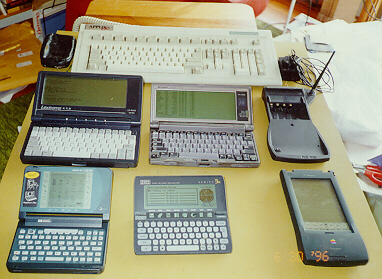Palmtop and Pocket Computer Notes
Reviews and notes on older palmtop computers 1990 to 2000.
Notes and reviews about pocket palmtop computers, and mobile take with you computing, circa 1990 to 2000. I don't believe any pocket palmtop computer will ever again be ready for use as your only computer. However it is obvious that having only a desktop computer is too limiting to contemplate.
Short notes on palmtops I have used
Sharp PC3100
My first palmtop was a Sharp PC3100 MS-Dos 3.3 system, which gave me good (albeit limited) service from October 1992. It has an excellent keyboard and display, and absolutely lousy PIM software. The PIM looks pretty, but it is incapable of handling any moderately large file. A mere 100k text file takes over a minute to load. As a result, the built-in software needed to be replaced with substitutes before you could use the Sharp.
I also disliked Sharp's attitude to long term support. Sharp specific cables were required for the ports, and these were overly expensive and hard to obtain. Laplink connectivity software builtin worked fine, as did several other types of connectivity software.
Abstract R&D Lexicomp LC8620
I found a more powerful and full featured Abstract R&D Lexicomp LC8620 as a replacement. Slightly larger than the Sharp, but included absolutely standard serial and parallel ports and a 40 mb hard drive. The software supplied was limited, but handy for all that, including a keyboard mouse driver. If you are into MS-Dos programs, the Lexicomp is great. The major problem is heavy battery consumption if you use the hard disk. The builtin fax-modem also worked well.
Newton Message Pad 110
I thought the display was marginal, and the hand writing recognition unusably bad. I couldn't seem to make any sort of long note on the Newton, due to file size limits. This appears a product best suited to using with ready made "tick box" software.
I wasn't able to transfer files to a PC as the PCMCIA cards did not seem to be readable elsewhere. The infra-red port did not appear IrDA compatible, so it wouldn't beam to notebook computers or my printer. I was not able to make my homemade serial cable work for file transfers - maybe it only works with a Macintosh. I rated the Newton as the least useful palmtop I had seen. I understand that later models had improved displays, and much better hand writing recognition.
Not Palmtop Sized
The Sharp, Lexicomp and Newton all had one serious and inescapable fault. They are not pocket sized (unless you have strange pockets). Although I carried each in my bag to work while testing, I found they tended to stay in my bag or on my desk, rather than being to hand when needed. I just didn't pick them up when I went to lunch or to a shop or whatever. So all three failed the "carry it always" test.
Hewlett Packard OmniGo 100
This was small enough to carry. With keyboard and pen, you have a choice of input. The Grafitti pen recognition worked pretty well for me.
However the display is far too small, and very hard to read. The worst palmtop display I have seen. The included software was very nice, and very complete, especially the financial calculator. The Geos O/S was far too slow in opening applications, or even swapping between applications. The non-standard serial cable was so expensive that I didn't buy it. The PCMCIA cards could be read, but the file formats were not even compatible with GeoWorks on a PC.
Battery life was very poor, and there is no provision for external power. Due to the slow operation, and poor display, I soon sold it!
Psion 3a
This has an excellent, clear 480 x 160 display. It is the best palmtop display I've used. I liked the keyboard better than the calculator style of the OmniGo. Strangely, I didn't miss the lack of a pen input. The Psion is even smaller than the OmniGo, and even more likely to be carried with you.
While reasonably easy to use, it does take longer to become really familiar with its features than with the Geos based OmniGo. The applications provided seemed to me even more powerful than the OmniGo, with the exception of the calculator, where the OmniGo was clearly superior. All the applications ran much faster than the OmniGo equivalent.
The Psion came with a serial transfer cable, and file trasfer and conversion software that worked well under MS Windows. File transfer could also be done under MS-Dos. Battery life (unlike the OmniGo) is excellent. Disadvantages include a proprietary storage module, which is very expensive compared to PCMCIA. At the moment, it is my favourite palmtop.
I eventually used only Psions as my palmtop computer.
Palmtop Sites elsewhere
I'm no longer keeping all these links up to date, and will probably remove many of them soon (updated March 2002 and Dec 2005).
- Hummingbird and Nightingale
- IrDA products from Actisys
- The Palmtop Shop, Sydney and Brisbane, Australia
- www.pdadirect.com PDA Direct store
- www.intellisync.com was once Starfish sync technology
- Pen Computing magazine
- Thaddeus Computing Palmtop Paper was once HP200LX and OmniGo magazine
- Thaddeus Palmtop Paper renovated HP200LX sales
- www.xybernaut.com was once Xybernaut portable and wearable computers
- Murray Barton's HP 200LX site formerly http://www.iinet.net.au/~muzza/hplx.html
- Mobilis magazine (not active) formerly http://www.volksware.com/mobilis
- Road Warriors formerly http://www.warrior.com
